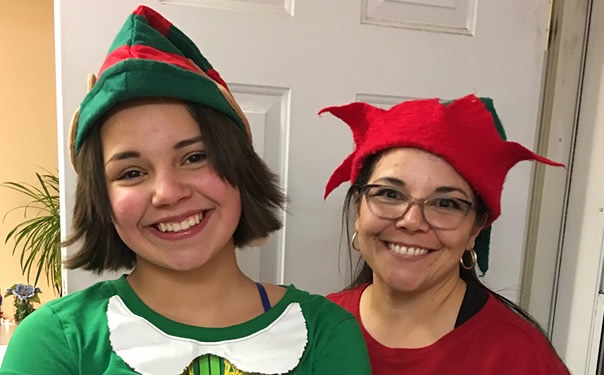Time and tradition are on a collision course in, of all places, Colorado’s San Luis Valley. But if the families of the Valley have a say in the matter, traditions that have been a cherished part of life there for nearly two centuries, will last, at least for a while longer.

As the Christmas season draws close, Valley resident Dana Maestas said locals—young and old—will begin looking forward to one of the Valley’s oldest religious traditions, Mis Christmas. It’s a religious ritual that began here decades before Colorado gained statehood. “Mis Christmas,” said Maestas, “usually starts nine nights before Christmas ending on Christmas Eve.”
While each Valley resident has their own individual ways of observing the holiday, there are several collective traditions that have been part of Valley life going back well before Colorado even gained statehood. Holiday customs, a blending of religious and fraternal observances, include Mis Christmas and La Posada.
While it has dimmed somewhat in recent years, Mis Christmas originally involved a collection of friends and relatives making stops in each of the villages that skirt the town of San Luis. They would do this for the nine nights preceding Christmas. Each of the villages had a luminaria, “a small bonfire,” Maestas called it, where people would sit around and tell stories or simply have conversations. Paths would also be adorned with farolitos, small paper bags filled with sand and a lighted candle.
While she could not say with certainty, Maestas guessed that the nine night ritual in the Valley might have a tangential connection to what the Jews of New Mexico did in celebrating the eight nights of Hanukkah.
La Posada, a long and cherished staple of the holidays in South and Central America and Mexico, came here as the migration north from Mexico and, later, southern Colorado began. The tradition goes back to the late 16th Century and originally began as a means of better telling the story of Joseph and Mary as they made their trek in search of lodging and the birth of Jesus. Now, as it was then, the procession includes song and prayer. It will, once again, be replayed in the Valley.
Another Valley tradition, said Maestas, whose family has been a part of these customs for generations, takes place on Christmas morning when “The older kids would dress as abuelitos (old men) wearing scary masks and take young kids to each home” where they would offer oremos or prayers. “The people there would invite them in and give them treats,” today, usually popcorn balls or apples. Sadly, said Maestas, “they don’t do it as much now.”
The newest holiday touch is the San Luis Manito Christmas, said Maestas. Begun five years ago, it’s the town’s Christmas for younger children. Main Street is decorated with farolitos, and everyone is invited to stay for the Christmas tree lighting. The city council also provides small toys, gift bags and everyone is served hot chocolate. This year, residents will be asked to fill out a survey that will help determine what a future community center will be like. The week’s activities are topped off by a Saturday night Christmas dinner and dance at the Cultural Center. Admission is free.
The timeline for these religious and cultural customs, said the Valley resident, began with the early 19th century arrival of Gregoria Martin and those few families who made the journey north from New Mexico. Martin settled in the village of San Francisco, one of the ten tiny com- munities in the shadow of San Luis. Others planted roots in the villages of San Acacio, San Isidro, Los Vallejos, San Pablo, San Pedro, Garcia and Chama. They made up the foundation of Colorado’s earliest farmers and ranchers. Of course, the lands were also occupied by indigenous people who had arrived centuries earlier.
The diminution of the religious customs celebrated in the Valley is the same one facing the rest of the nation. Very simply, fewer and fewer people are participating in church and religion in general. “I spoke to a friend who now lives in Lone Tree,” said Maestas, “who said ‘I don’t go to church very often.’” It’s a reality that people once raised in the church, have slowly been moving away or eschewing it altogether.
A 2021 Gallup Poll said that the plunge has been precipitous. Between 1953 and 1967, 98 percent of those polled said they believed in God. Last year, Gallup said that only 81 percent professed a belief in God. Also contribut- ing to the dilution in participation in these customs is the simple fact that younger people, including those in the Valley, are leaving for college or for better career opportu- nities. There is also one other thing, said Maestas.
There was a time when each of the villages had its own church—usually Catholic. That no longer is the case. Today one Catholic church serves the Valley, and it is in the town of San Luis. Another variable in this equation is leadership. Not all priests, especially recently, said Maestas, have had the same enthusiasm for the customs as their predecessors. Not every priest, she said, is a Father Pat.
Father Pat was a long-serving San Luis priest and ardent supporter of Christmas religious traditions. He was foundational in the lives of many Valley residents but was reassigned several years ago.
Still, despite the challenges of a new century, Maestas said she believes the traditions of the Valley are important.
“They are just part of the culture and who you are…it’s like language. You have to keep them alive.”





